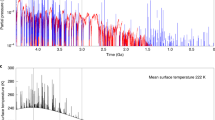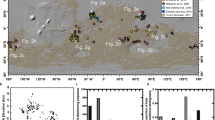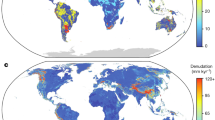Abstract
Reduced greenhouse gases such as methane (CH4) and hydrogen (H2) might be the only tenable solution to explain warming of the ancient Martian climate, but direct geological evidence that a reduced atmosphere actually existed on Mars has been lacking. Here we report widespread, strong Fe loss in chemically weathered bedrock sections in the Mawrth Vallis region and other 3–4-billion-year-old terrains on Mars. The separation of Fe from Al in Martian palaeosols, which is comparable to trends observed in palaeosols before the Great Oxidation Event on Earth, suggests that the ancient Martian surface was chemically weathered under a reducing greenhouse atmosphere. Although for different reasons than on Earth, Mars underwent an oxidation event of its own in the late Noachian that forever changed the geological path of the planet.
This is a preview of subscription content, access via your institution
Access options
Access Nature and 54 other Nature Portfolio journals
Get Nature+, our best-value online-access subscription
$29.99 / 30 days
cancel any time
Subscribe to this journal
Receive 12 digital issues and online access to articles
$119.00 per year
only $9.92 per issue
Buy this article
- Purchase on Springer Link
- Instant access to full article PDF
Prices may be subject to local taxes which are calculated during checkout







Similar content being viewed by others
Data availability
Data required to complete this work include: (1) hyperspectral image cubes from CRISM; (2) high-resolution colour images and digital elevation information from HiRISE; (3) regional images from the Mars Orbiter Camera; (4) reference spectra from the CAT_ENVI and ASD spectral libraries; and (5) spectral parameters and Fe concentration of Hainan basaltic weathering products. All remote sensing data used in this work are available through the Planetary Data System (https://pds.nasa.gov). Other planetary datasets are available within the JMARS software provided by Arizona State University (https://jmars.asu.edu).
Code availability
The software used to process the CRISM data is available through the Planetary Data System (https://pds.nasa.gov). Other visualization capabilities are available within the JMARS software provided by Arizona State University (https://jmars.asu.edu).
References
Ramirez, R. M. et al. Warming early Mars with CO2 and H2. Nat. Geosci. 7, 59–63 (2014).
Wordsworth, R. et al. Transient reducing greenhouse warming on early Mars. Geophys. Res. Lett. 44, 665–671 (2017).
Sholes, S. F., Smith, M. L., Claire, M. W., Zahnle, K. J. & Catling, D. C. Anoxic atmospheres on Mars driven by volcanism: implications for past environments and life. Icarus 290, 46–62 (2017).
Tarnas, J. D. et al. Radiolytic H2 production on Noachian Mars: implications for habitability and atmospheric warming. Earth Planet. Sci. Lett. 502, 133–145 (2018).
Tosca, N. J., Ahmed, I. A. M., Tutolo, B. M., Ashpitel, A. & Hurowitz, J. A. Magnetite authigenesis and the warming of early Mars. Nat. Geosci. 11, 635–639 (2018).
Oze, C. & Sharma, M. Have olivine, will gas: serpentinization and the abiogenic production of methane on Mars. Geophys. Res. Lett. 32, L10203 (2005).
Haberle, R. M., Zahnle, K., Barlow, N. G. & Steakley, K. E. Impact degassing of H2 on early Mars and its effect on the climate system. Geophys. Res. Lett. 46, 13355–13362 (2019).
Kite, E. S. et al. Methane bursts as a trigger for intermittent lake-forming climates on post-Noachian Mars. Nat. Geosci. 10, 737–740 (2017).
Mitra, K. & Catalano, J. G. Chlorate as a potential oxidant on Mars: rates and products of dissolved Fe(II) oxidation. J. Geophys. Res. Planets 124, 2893–2916 (2019).
Chemtob, S. M., Nickerson, R. D., Morris, R. V., Agresti, D. G. & Catalano, J. G. Oxidative alteration of ferrous smectites and implications for the redox evolution of early Mars. J. Geophys. Res. Planets 12, 2469–2488 (2017).
Rye, R. & Holland, H. D. Paleosols and the evolution of atmospheric oxygen: a critical review. Am. J. Sci. 298, 621–672 (1998).
Liu, J. C. et al. Reflectance spectroscopy applied to clay mineralogy and alteration intensity of a thick basaltic weathering sequence in Hainan Island, South China. Appl. Clay Sci. https://doi.org/10.1016/j.clay.2020.105923 (2020).
Loizeau, D. et al. Stratigraphy in the Mawrth Vallis region through OMEGA, HRSC color imagery and DTM. Icarus 205, 396–418 (2010).
McKeown, N. K. et al. Characterization of phyllosilicates observed in the central Mawrth Vallis region, Mars, their potential formational processes, and implications for past climate. J. Geophys. Res. 114, E00D10 (2009).
Greenberger, R. N. et al. Low temperature aqueous alteration of basalt: mineral assemblages of Deccan basalts and implications for Mars. J. Geophys. Res. Planets 117, E00J12 (2012).
Carter, J., Loizeau, D., Mangold, N., Poulet, F. & Bibring, J.-P. Widespread surface weathering on early Mars: a case for a warmer and wetter climate. Icarus 248, 373–382 (2015).
Noe Dobrea, E. Z. et al. Mineralogy and stratigraphy of phyllosilicate-bearing and dark mantling units in the greater Mawrth Vallis/west Arabia Terra area: constraints on geological origin. J. Geophys. Res. 115, E00D19 (2010).
Bishop, J. L. et al. Surface clay formation during short-term warmer and wetter conditions on a largely cold ancient Mars. Nat. Astron. 2, 206–213 (2018).
Poulet, F. et al. Mawrth Vallis, Mars: a fascinating place for future in situ exploration. Astrobiology 20, 199–234 (2020).
Bishop, J. L. et al. Multiple mineral horizons in layered outcrops at Mawrth Vallis, Mars, signify changing geochemical environments on early Mars. Icarus 341, 113634 (2020).
Bishop, J. L. et al. Phyllosilicate diversity and past aqueous activity revealed at Mawrth Vallis, Mars. Science 321, 830–833 (2008).
Bishop, J. L. et al. What the ancient phyllosilicates at Mawrth Vallis can tell us about possible habitability on early Mars. Planet. Space Sci. 86, 130–149 (2013).
Michalski, J. R. et al. The Mawrth Vallis region of Mars: a potential landing site for the Mars Science Laboratory (MSL) mission. Astrobiology 10, 687–703 (2010).
Wray, J. J., Ehlmann, B. L., Squyres, S. W., Mustard, J. F. & Kirk, R. L. Compositional stratigraphy of clay-bearing layered deposits at Mawrth Vallis, Mars. Geophys. Res. Lett. 35, L12202 (2008).
Lowe, D. R., Bishop, J. L., Loizeau, D., Wray, J. J. & Beyer, R. A. Deposition of >3.7 Ga clay-rich strata of the Mawrth Vallis Group, Mars, in lacustrine, alluvial, and aeolian environments. GSA Bull. 132, 17–30 (2020).
Dundas, C. M. et al. Exposed subsurface ice sheets in the Martian mid-latitudes. Science 359, 199–201 (2018).
Delamere, W. A. et al. Color imaging of Mars by the High Resolution Imaging Science Experiment (HiRISE). Icarus 205, 38–52 (2010).
Tornabene, L. L. et al. Image simulation and assessment of the colour and spatial capabilities of the Colour and Stereo Surface Imaging System (CaSSIS) on the ExoMars Trace Gas Orbiter. Space Sci. Rev. 214, 18 (2018).
Hurowitz, J. A. et al. In situ and experimental evidence for acidic weathering of rocks and soils on Mars. J. Geophys. Res. Planets 111, E02S19 (2006).
Golombek, M. P. et al. Erosion rates at the Mars Exploration Rover landing sites and long-term climate change on Mars. J. Geophys. Res. 111, E12S10 (2006).
Michalski, J. R., Dobrea, E. Z. N., Niles, P. B. & Cuadros, J. Ancient hydrothermal seafloor deposits in Eridania basin on Mars. Nat. Commun. 8, 15978 (2017).
Michalski, J. R. et al. The geology and astrobiology of McLaughlin Crater, Mars: an ancient lacustrine basin containing turbidites, mudstones, and serpentinites. J. Geophys. Res. Planets 124, 910–940 (2019).
Dehouck, E., Gaudin, A., Chevrier, V. & Mangold, N. Mineralogical record of the redox conditions on early Mars. Icarus 271, 67–75 (2016).
Hurowitz, J. A. & McLennan, S. M. A ~3.5 Ga record of water-limited, acidic weathering conditions on Mars. Earth Planet. Sci. Lett. 260, 432–443 (2007).
Hurowitz, J. A., Fischer, W. W., Tosca, N. J. & Milliken, R. E. Origin of acidic surface waters and the evolution of atmospheric chemistry on early Mars. Nat. Geosci. 3, 323–326 (2010).
Carter, J., Poulet, F., Bibring, J. P., Mangold, N. & Murchie, S. Hydrous minerals on Mars as seen by the CRISM and OMEGA imaging spectrometers: updated global view. J. Geophys. Res. Planets 118, 831–858 (2013).
Ehlmann, B. L. & Edwards, C. S. Mineralogy of the Martian surface. Annu. Rev. Earth Planet. Sci. 42, 291–315 (2014).
Michalski, J. R. et al. Constraints on the crystal-chemistry of Fe/Mg-rich smectitic clays on Mars and links to global alteration trends. Earth Planet. Sci. Lett. 427, 215–225 (2015).
Catalano, J. G. Thermodynamic and mass balance constraints on iron-bearing phyllosilicate formation and alteration pathways on early Mars. J. Geophys. Res. Planets 118, 2124–2136 (2013).
Michalski, J. R. et al. Shock metamorphism of clay minerals on Mars by meteor impact. Geophys. Res. Lett. 44, 6562–6569 (2017).
Jakosky, B. M. et al. Loss of the Martian atmosphere to space: present-day loss rates determined from MAVEN observations and integrated loss through time. Icarus 315, 146–157 (2018).
Carrier, B. L. & Kounaves, S. P. The origins of perchlorate in the Martian soil. Geophys. Res. Lett. 42, 3739–3745 (2015).
Michalski, J. R. et al. The Martian subsurface as a potential window into the origin of life. Nat. Geosci. 11, 21–26 (2018).
He, Y. et al. Clay minerals in a soil chronosequence derived from basalt on Hainan Island, China and its implication for pedogenesis. Geoderma 148, 206–212 (2008).
Viviano-Beck, C. E. et al. Revised CRISM spectral parameters and summary products based on the currently detected mineral diversity on Mars. J. Geophys. Res. Planets 119, 1403–1431 (2014).
Percival, J. B. et al. Customized spectral libraries for effective mineral exploration: mining national mineral collections. Clays Clay Miner. 66, 297–314 (2018).
Acknowledgements
This work was funded by the Research Grants Council General Research Fund to J.R.M. (grant number 17307417) and the National Natural Science Foundation of China (grant number 91962216). J.R.M. acknowledges support from the Canadian Institute For Advanced Research Earth 4-D Program. We thank G. Wei, L. Chen and J. Huang for sample preparation and M. F. Zhou, Y. Yao, L. Chen, X. Qin, D. Hao and K. Song for spectral and chemical measurements.
Author information
Authors and Affiliations
Contributions
J.L. carried out all spectral and geological analyses and wrote the manuscript. J.R.M. conceptualized the project and helped write the paper. W.T. contributed to the interpretation of the data and revisions of the manuscript. H.H. provided the Hainan core samples and helped interpret weathering processes. L.X. contributed to early phases of the project. B.Y. helped analyse some CRISM and HiRISE images.
Corresponding author
Ethics declarations
Competing interests
The authors declare no competing interests.
Additional information
Peer review information Nature Astronomy thanks Steven Chemtob and the other, anonymous, reviewer(s) for their contribution to the peer review of this work.
Publisher’s note Springer Nature remains neutral with regard to jurisdictional claims in published maps and institutional affiliations.
Supplementary information
Supplementary Information
Supplementary Figs. 1–6, Tables 1 and 2, discussion and references.
Rights and permissions
About this article
Cite this article
Liu, J., Michalski, J.R., Tan, W. et al. Anoxic chemical weathering under a reducing greenhouse on early Mars. Nat Astron 5, 503–509 (2021). https://doi.org/10.1038/s41550-021-01303-5
Received:
Accepted:
Published:
Issue Date:
DOI: https://doi.org/10.1038/s41550-021-01303-5
This article is cited by
-
Paleoclimatic application of spectral parameters to the eolian red clay of the Jianzha Basin, northeastern margin of the Tibetan Plateau
Science China Earth Sciences (2024)
-
Early Mars habitability and global cooling by H2-based methanogens
Nature Astronomy (2022)
-
Chemical weathering over hundreds of millions of years of greenhouse conditions on Mars
Communications Earth & Environment (2022)



